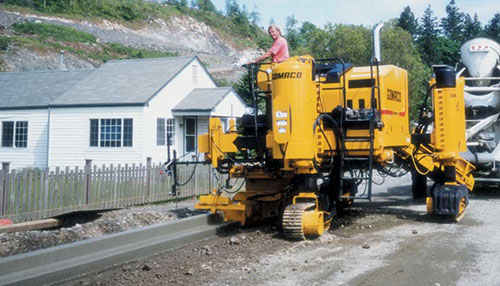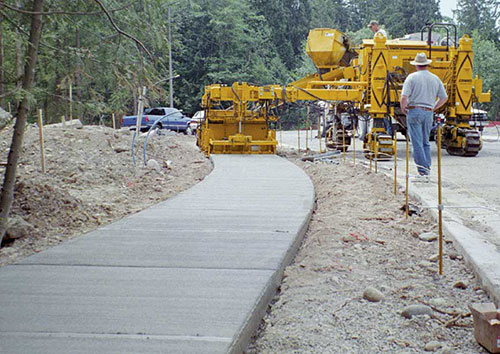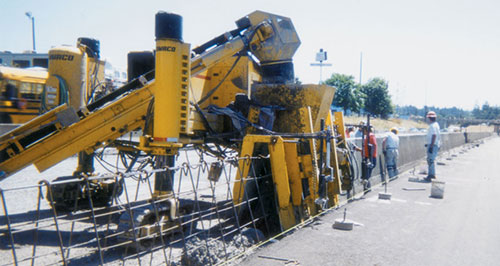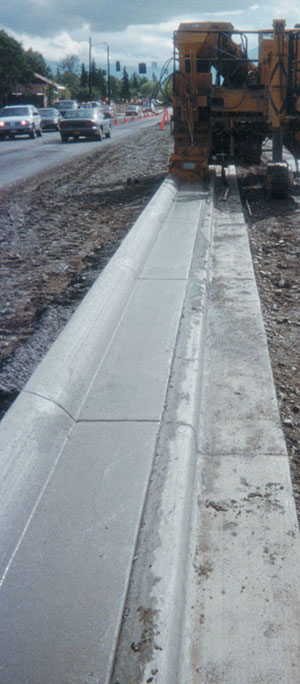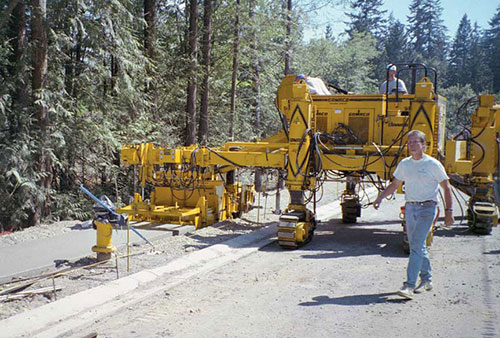GOMACO World Index --- GOMACO World 30.2 - April 2002
Building A Fleet Of New Generation Commander IIIs
The principles of Finishing Edge LLC started in the slipforming business in 1984 with the purchase of a GOMACO Commander II curb and gutter machine. It was sent to Alaska and has worked up and down the West Coast the last 18 years.
The growth and success of the company led to the purchase of more GOMACO machines and the expansion of the company into Washington and, just last year, Hawaii. Their current machine inventory includes their original Commander II, a GT-3600, a four-track Commander III and three new generation Commander IIIs, with two more on order for 2002.
"Our plans are to eventually have all new generation Commander IIIs everywhere because of their versatility," Craig Morrison, managing partner of Finishing Edge, said. "They have what we need for the variety of conditions we have to work with around here."
It has the versatility to handle a variety of slipform applications, from curb and gutter to barrier wall to sidewalk. The Commander III also comes with a trimmerhead that has more than enough power to trim through the rocky grade.
"In our part of the country, especially in Washington and Alaska, the native material around here is very boney," Morrison explained. "It's one of the reasons why we never felt like we could ever go with any other kind of machine and it's why we prefer the Commander III. It's built heavy enough and has enough power to get through it."
In one year's time, Finishing Edge will slipform over 400,000 lineal feet (121,920 m) of 18 inch (457 mm) vertical curb. That's just one application and it's only in the state of the Washington. With that kind of production, it's important to Morrison to have a machine that can both trim and pour simultaneously.
"We'll have guys come around here with their really light machines and they'll try to sell us on the fact they can trim and pour," Morrison said. "We look at them and how light their machines are and we know it's ridiculous."
"There's no way they could perform," Chris Klassen, general manager for Finishing Edge, said. "Guys that use those machines have to trim first and then come back and pour. We can't waste days like that. We move in and we're pouring."
An average day's production of 18 inch (457 mm) vertical curb will vary between 2500 to 3500 feet (762 to 1067 m). A seven man crew works with and around the machine. Catch basins, driveway cutouts and wheel chair ramps are an extra hassle the crew has to deal with, but features on the new generation Commander III help out.
The sideshifting, vertical-lifting trimmerhead decreases the amount of tie-in work around the objects.
"The offset trimmerhead and mold allow us to get into tight areas, just like we can with our GT-3600. It's a wonderful option," Morrison explained. "We are definitely big on putting in our catch basins as we go, we don't like leaving any patches. The Commander III lets us do that very easily."
Finishing Edge's curb and gutter molds are also equipped with driveway blockouts.
"The driveway blockouts work very good," Klassen said. "They save us both time and concrete."
An interesting application Finishing Edge slipforms is piggyback curb and gutter along medians in Alaska. One pass of curb and gutter is slipformed and then a second is added right next to it. Approximately 10,000 feet (3048 m) of piggyback curb and gutter was slipformed in Alaska as part of the largest landscape contract the state has ever let out.
"Alaska is such a tourist state during the summer and they love to have median islands on all their highways up there with nice plants," Morrison explained. "The piggyback curb and gutter is the only thing they've found that will keep the snowplows out of the medians. The plow will hit the first one and use that as their guide. If they pop over that one, they'll hit another curb instead of plowing through all the trees and plants."
Piggyback curb and gutter is a fairly new application in Alaska. Morrison said if they get more of that type of work, they'd consider buying a monolithic mold and pour both sets of curb and gutter in one pass. A 5.5 to 6 sack concrete mix design with a 1.5 inch (38 mm) slump was used for the project.
Curb and gutter isn't the only application Finishing Edge specializes in, variable height barrier and sidewalks are others. The state of Washington has adopted Texas barrier as a federal standard. On one project, Finishing Edge slipformed approximately 5,000 feet (1524 m) of variable height, single slope Texas barrier.
The height of the wall varied between 3.5 to 6 feet (1.07 to 1.83 m). Average width at the top was eight inches (203 mm) and the bottom reached over 24 inches (610 mm) wide at the wall's full height. Hydraulic sideplates on the mold have 18 inches (457 mm) of vertical adjustment to accomplish the variable heights.
"The important thing when pouring wall over caged steel is to get the steel in place and secure and do it right the first time," Klassen explained. "The day before we pour, we go through and do a dry run. We walk the machine and the mold over the steel. As we get it into place, we blob it with concrete to hold it in place."
A Washington state six-sack concrete mix design with a 4000 psi (30 MPa) is used for the barrier. Slump averages one inch (25 mm). A broom finish is applied to the wall and joints are cut in every eight feet (2.44 m). Average production is 1500 feet (457 m) per day.
Sidewalk is also a specialty. Finishing Edge has a special 12 foot (3.66 m) extension that can be fitted onto their Commander III that allows them to slipform sidewalk and still keep their machine on the roadway.
"We can keep the entire machine, all the tracks, on the roadway and pour a five foot (1.52 m) sidewalk with 6.5 foot (1.98 m) planter," Morrison said. "We wanted a design that would allow us to get over obstacles like hydrants and the extension allows us to do that. We just can't get over light poles. We haven't figured that one out yet."
Normally, on a sidewalk project, the sensors are run off the existing curb. The only time stringline is set is when the sidewalk has a varying width. Average production is dictated by the rate of concrete delivery.
"Everyone knows about Seattle traffic, right? Our biggest problem is just getting the concrete. You can drive down the freeway and see five of your mixer trucks and you know they're going to your job but they're stuck in traffic," Morrison said. "That's a real battle and ongoing problem for us. We have to take delivery into account and shorten our crew sizes because we know we're only going to get 100 yd3 (76 m3) in an eight-hour period."
The thickness of the concrete sidewalk varies between four to six inches (102 to 152 mm) depending on the specification.
"We can vary our trimmer up and down, the same way you would with curb and gutter, so we can pour four inches (102 mm) thick and, when we come across a driveway, we can lower the trimmerhead down to create a six inch (152 mm) drive approach," Klassen explained. "The mold has hydraulic sideplates on it so we can vary the thickness."
Managing projects in three different states, with totally different climates, and four separate offices can be challenging.
"Find your people first," Morrison advised. "We have good people and that really helps. It's very tricky to plan and be efficient and mobilize equipment around Alaska and now Hawaii."
And what about Finishing Edge's original Commander II?
"We call our Commander II our 'Old Girl,' and it is probably one of the most traveled machines there is. I can't count the number of times it's been up and down the west coast on barges," Morrison said. "This summer we're going to put it on a C-130 and fly it into Kotsebue, Alaska, to slipform 12,000 feet (3658 m) of curb and gutter there. That machine has probably been paid for a hundred times, so if it sits somewhere for a whole season and only works in that one town, so be it. We've still made money.
"We'll never get rid of our Commander II, it's the original. In fact, we're thinking it might make its way to Hawaii to retire."
Subscribe to Receive GOMACO World Magazine
